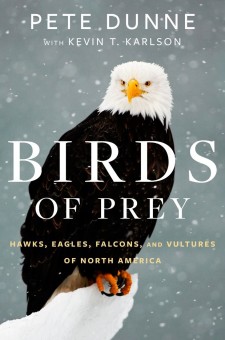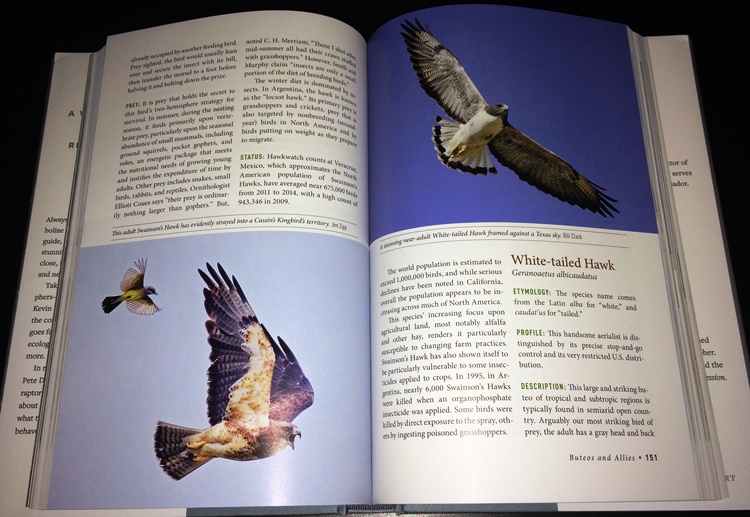Reviewed by Grant McCreary on May 6th, 2017.
Birds of Prey: Hawks, Eagles, Falcons, and Vultures of North America seems to fit the mold of a traditional guide focused on the natural history of a family, being comprised of 33 species accounts, one for each of the regularly occurring diurnal raptors of the continental United States and Canada, each well-illustrated with photographs. Yet, in several key ways it departs from what one expects out of such a guide. The result is surprisingly refreshing.
Writing a species account is a tough, thankless job. It needs to present what is known about the bird in a clear, logical manner so that specific information is readily found. And yet, it should ideally be more than a recitation of facts. A good species account goes beyond the what, when, and where of the subject’s life to communicate what it is like and perhaps even what it is like to be one. And to do all that in a manner that is a true pleasure to read? That is rare, indeed. But Pete Dunne has pulled it off here.
The species accounts, upon initial inspection, look no different from those found in countless other books. They are divided into these sections:
- Etymology – the origin of the common and scientific names
- Profile – an overall portrayal of the bird
- Description – physical description, including plumage and relative size
- Measurements – length, wingspan, and weight
- Systematics/Subspecies
- Vocalizations
- Distribution – within North America and without, if applicable
- Migration
- Habitat
- Breeding – from pair formation through fledging young
- Behavior/Hunting
- Prey
- Status – population trends and conservation efforts
The accounts are extensively researched, as evidenced by the considerable bibliographic notes in the back of the book. In Birds of Prey, you should be able to find the answer to any basic question you may have about the natural history of these raptors. But it is not the facts that sets this book apart. It is the weaving of those facts with narrative – Dunne’s personal experience as well as that of others – in the particular, inimitable manner unique to the author. A species account written by Pete Dunne is more riveting than a thriller by most any novelist.
For example, of the Northern Goshawk’s behavior when disturbed at its nest, it would be sufficient to say that it gives a “loud and high-pitched” call and acts aggressively. But Dunne describes it in a manner that gets the point across much better. He further describes the point of this “no-nonsense” call: “It is intended to get your attention. If it doesn’t, the bird that is threatening to decapitate you most certainly will.”
The way the accounts are broken down categorically could, however, lead to some missed information if you don’t read the entire account. For instance, in the Behavior/Hunting section of the Northern Goshawk account, Dunne pronounces that “any accounting of Goshawk prey that fails to mention Snowshoe Hare and Ruffed Grouse by name is sadly remiss”, yet does not mention those two by name in the Prey section of his own account. If you’re looking for a particular bit of information on one of these birds, it is best to read the entire account.
Doing so, however, is most certainly not time or effort wasted. You are bound to come across something interesting, such as:
- The Osprey’s crooked wing may be an adaptation to its fishing proclivities, allowing it to plunge into the water without injury and then be able to lift off again.
- Unlike most buteos, Zone-tailed Hawk does not have a distinct juvenile plumage, which lends support to the theory that they mimic Turkey Vultures in order to catch their prey unaware.
Another way in which Birds of Prey differs from most such family guides is in its size: It is smaller than I was expecting. For example, it is approximately 25% smaller than volumes in the Peterson Reference Guide series, from the same publisher. (Speaking of which, I was surprised this wasn’t included in that series, given that they have the same focus. Apparently, it is simply a matter of how the contract was initially signed up.) Its size is more appropriate for guides intended for field identification. In fact, it is the same size as Dunne’s identification-oriented Hawks in Flight. But perhaps that isn’t a coincidence. Dunne states in the introduction here that his “initial objective was to craft a companion to Hawks in Flight.” He goes on to write: “What I set out to do with this book was put some biological flesh and feather upon the bare outline of an identification.” So, perhaps, this guide is sized as it is because it’s meant to be used in the field. And it certainly could be. However, the smaller size does have one drawback: the images have less of an impact.
While that doesn’t hinder the guide’s primary purpose, it is a shame since Birds of Prey is filled with fantastic photographs. That’s unsurprising, though, with Kevin Karlson’s involvement. Karlson, an excellent photographer, served as photo editor, selecting and processing the pictures that best supplement the text. The photos, taken by Karlson and many other talented photographers, do indeed depict a wide variety of behaviors, from raptors with prey to Bald Eagles tumbling through the air mid-courtship. Many accounts also have one or more “samplers”, a grid of smaller photos showing the species in different plumages – adult, juvenile, subspecies – perched and in flight. This was a wise use of space. On one hand, this is not an identification guide so it doesn’t need large, detailed photos of every plumage. But on the other hand, it is extremely helpful for readers to have a visual reference to the descriptions in the text. Altogether, this guide has a visual impact beyond its relatively small size.
Recommendation
Birds of Prey: Hawks, Eagles, Falcons, and Vultures of North America is by far the most interesting, I would go as far as to say gripping, way of learning about these birds. Whether you read it at home or during lulls at your favorite hawk watch, whether it would be your first book about raptors or you already have a shelf full of them, it deserves a place in your library.
Disclosure: I get a small commission for purchases made through links in this post.
Buy from NHBS
(based in the U.K.)
Disclosure: The item reviewed here was a complementary review copy provided by the publisher. But the opinion expressed here is my own, it has not been influenced in any way.







FYI – I’m shutting down comments on this post because, for some reason, it gets targeted by lots of spam. If you have any legit comment or feedback, you can reach me via email, facebook, or twitter.
[…] Dunne’s books are all nice. I obtained Birds of Prey: Hawks, Eagles, Falcons, and Vultures of North America as a birthday present from a fellow raptor counter. Dunne is a wonderful author, with a readable […]